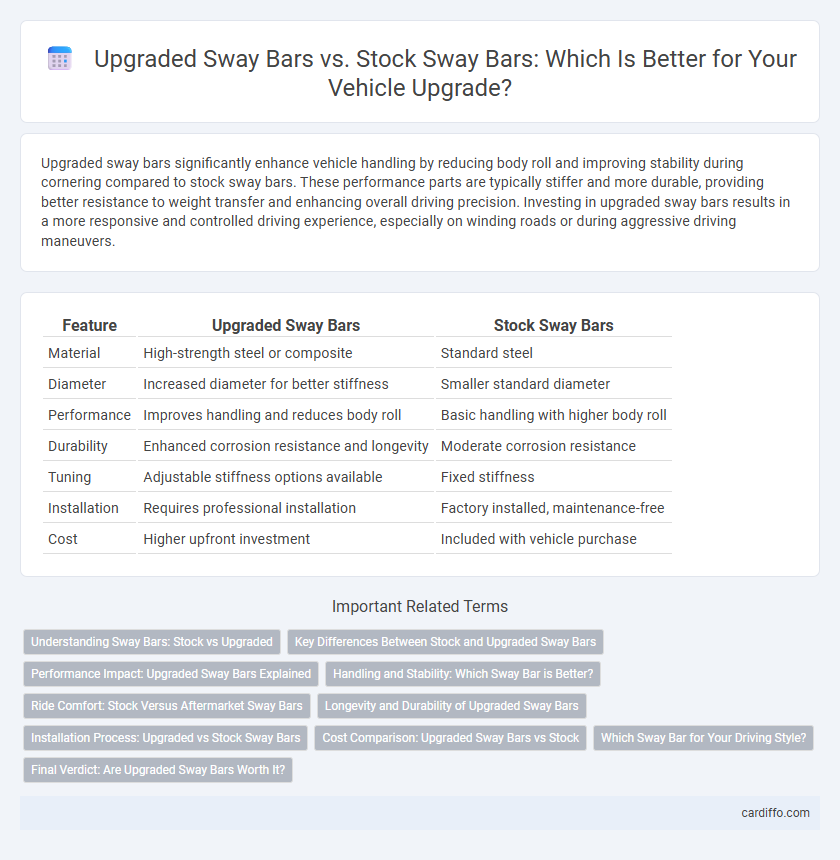Upgraded sway bars significantly enhance vehicle handling by reducing body roll and improving stability during cornering compared to stock sway bars. These performance parts are typically stiffer and more durable, providing better resistance to weight transfer and enhancing overall driving precision. Investing in upgraded sway bars results in a more responsive and controlled driving experience, especially on winding roads or during aggressive driving maneuvers.
Table of Comparison
| Feature | Upgraded Sway Bars | Stock Sway Bars |
|---|---|---|
| Material | High-strength steel or composite | Standard steel |
| Diameter | Increased diameter for better stiffness | Smaller standard diameter |
| Performance | Improves handling and reduces body roll | Basic handling with higher body roll |
| Durability | Enhanced corrosion resistance and longevity | Moderate corrosion resistance |
| Tuning | Adjustable stiffness options available | Fixed stiffness |
| Installation | Requires professional installation | Factory installed, maintenance-free |
| Cost | Higher upfront investment | Included with vehicle purchase |
Understanding Sway Bars: Stock vs Upgraded
Upgraded sway bars offer enhanced stability and reduced body roll compared to stock sway bars, improving handling during sharp turns and aggressive driving. While stock sway bars are designed for general use and comfort, upgraded versions feature thicker bars and stronger end links to withstand higher stresses and provide better vehicle control. Investing in upgraded sway bars optimizes suspension performance, especially for sports cars and off-road vehicles, where precision and responsiveness are critical.
Key Differences Between Stock and Upgraded Sway Bars
Upgraded sway bars offer increased torsional stiffness compared to stock sway bars, significantly reducing body roll during cornering and improving vehicle handling and stability. Made from stronger materials and often thicker in diameter, upgraded sway bars provide enhanced resistance to flex, resulting in more precise steering response and better traction. Unlike stock sway bars designed for general use, performance-oriented upgraded sway bars cater to aggressive driving conditions, track use, and off-road applications.
Performance Impact: Upgraded Sway Bars Explained
Upgraded sway bars significantly enhance vehicle stability by reducing body roll during cornering, resulting in improved handling and a more responsive driving experience compared to stock sway bars. These performance rods are often constructed from higher-grade materials with thicker diameters, increasing torsional stiffness to better distribute weight across the suspension. This upgrade leads to increased traction and control, particularly in aggressive driving or off-road conditions, offering a noticeable improvement over factory-installed components.
Handling and Stability: Which Sway Bar is Better?
Upgraded sway bars improve handling and stability by reducing body roll and enhancing cornering performance compared to stock sway bars, which often allow more flex and less responsiveness. Performance vehicles benefit from stiffer upgraded sway bars that provide better weight distribution and traction during high-speed maneuvers. Choosing upgraded sway bars leads to a more controlled driving experience, especially on winding roads and during aggressive driving.
Ride Comfort: Stock Versus Aftermarket Sway Bars
Upgraded sway bars improve ride comfort by reducing body roll and enhancing vehicle stability compared to stock sway bars, which tend to offer a softer, less controlled ride. Aftermarket sway bars are designed with stiffer materials and adjustable settings that optimize handling without compromising suspension compliance. Upgraded sway bars minimize sway during cornering, resulting in a smoother, more secure driving experience on various road conditions.
Longevity and Durability of Upgraded Sway Bars
Upgraded sway bars are engineered with higher-grade materials such as chromoly steel or reinforced alloys, significantly enhancing their longevity compared to stock sway bars made from standard steel. Their increased thickness and advanced manufacturing processes reduce metal fatigue and resistance to corrosion, ensuring prolonged durability under extreme driving conditions. This durability translates to consistent performance over time, minimizing the need for frequent replacements and offering better value in vehicle suspension upgrades.
Installation Process: Upgraded vs Stock Sway Bars
Upgraded sway bars typically require a more complex installation process than stock sway bars due to their custom fit and additional hardware components, often involving precise alignment and torque specifications. Stock sway bars offer a straightforward, factory-compatible installation with fewer steps and standard mounting points, making them more accessible for quick replacements. Proper installation of upgraded sway bars demands specialized tools and mechanical knowledge to ensure optimal handling performance and durability.
Cost Comparison: Upgraded Sway Bars vs Stock
Upgraded sway bars typically cost between $150 and $500, depending on brand and material quality, while stock sway bars range from $50 to $150. The higher price of upgraded sway bars reflects enhanced performance benefits, such as improved handling and reduced body roll. Investing in upgraded sway bars offers long-term value by enhancing vehicle stability and potentially lowering maintenance costs associated with excessive wear on suspension components.
Which Sway Bar for Your Driving Style?
Upgraded sway bars offer increased stiffness and improved handling performance compared to stock sway bars, making them ideal for aggressive driving and track use. Stock sway bars provide a more comfortable, compliant ride suitable for daily driving and light cornering. Choosing the right sway bar depends on whether you prioritize ride comfort or enhanced cornering stability tailored to your specific driving style.
Final Verdict: Are Upgraded Sway Bars Worth It?
Upgraded sway bars significantly enhance vehicle stability and reduce body roll compared to stock sway bars, providing improved handling during aggressive cornering and spirited driving. The increased diameter and stiffer construction of aftermarket sway bars translate to better weight distribution and enhanced grip, especially in performance-oriented vehicles. For drivers seeking sharper steering response and improved safety without compromising ride comfort, investing in upgraded sway bars is a worthwhile upgrade.
Upgraded Sway Bars vs Stock Sway Bars Infographic

 cardiffo.com
cardiffo.com